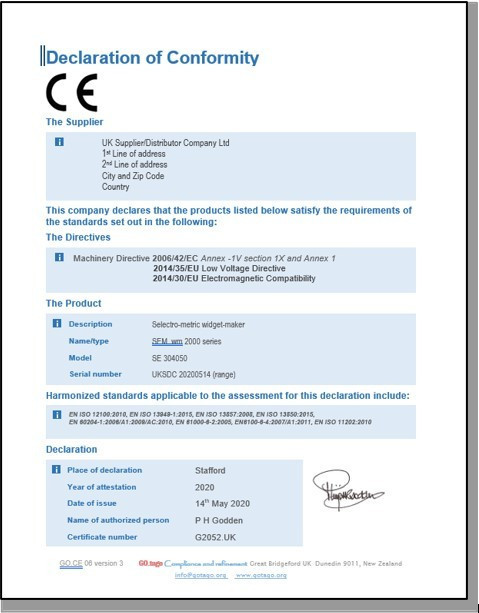CE Marking Conformité Européene
The letters "CE" are the abbreviation of French phrase "Conformité Européene" which literally means"European Conformity".The term initially used was "EC Mark" and it was officially replaced by "CE Marking" in the Directive 93/68/EEC in 1993
CE Marking is a certification mark that indicates conformity with health, safety, and environmental protection standards for products sold within the European Economic Area (EEA). … The CE marking is the manufacturer's declaration that the product meets EU standards for health, safety, and environmental protection
Obtaining certification for machinery as an example, commences with the European Machinery Directive 2006/42/EC under the Health and Safety at Work Act. This Directive requires conformity of Harmonised European Standards that have been adopted by the legislator to demonstrate specific aspects of safety relating to that particular machine. For instance an industrial sewing machine must meet BS EN ISO 10821:2005+A1:2009: Safety requirements for sewing machines, units and systems.
A full Risk Analysis and Risk Assessment must be applied and added into the Technical Construction file (TCF).
Operating and maintenance instructions for the end user are required, set out as stipulated in a further Standard.
Only on completion of this process can a mark be affixed, and a Declaration of Conformity issued.
Your GO.tago Practitioner will guide you through the CE Marking process if you are a putting a product onto the market.
There is a process. This however is not onerous although it is not done in 5 minutes. It will necessitate close cooperation with the OEM (Original Equipment Manufacturer) if that is not you, but all technical information remains highly confidential. In some cases a third party, a Notified Body may be required in conformity to the assessment procedures.
"If you are in the UK and selling products onto the home or export market, or are outside the UK and EU providing goods and services into this area, check whether your Declaration is in order and up to date"
The Health and Safety at Work etc Act 1974, contains general requirements for the manufacture and supply of safe workplace machinery (including second-hand machinery). Under this act, more specific legal requirements are stipulated in The Supply of Machinery (Safety) Regulations 2008. These in turn implement the European Machinery Directive 2006/42/EC because the UK continues to adopt European law.
" Check the CE mark has an indented centre on the E
There are substitutes with all the E bars equal.
These are not legal.
Check the harmonised standards are current. Many are withdrawn and upgraded."
If in doubt, ask.
Amongst the European Union legislation of Regulations, Directives, Decisions, Recommendation and Opinions, the important requirements affecting the manufacture, distribution, 'putting on the Market' sector in industry are the Directives.
The EU currently approves on average 80 directives per year.
A Directive is a legal act of the European Union which requires member states to achieve a particular result without dictating the means of achieving that result. It can be distinguished from regulations, which are self-executing and do not require any implementing measures.
The eight steps to conformity
1. Define which directives/ standards apply
2. Execute conformity assessment
3. Apply safety requirements
4. Execute risk analysis
5. Complementation of the technical construction file
6. Draw up directions for use
7. Draw up declaration of conformity
8. Affixing of the CE-marking
The UK has left the EU, and the UKCA (UK Conformity Assessed) marking is a new UK product marking that will be used for goods being placed on the market in Great Britain (England, Wales and Scotland). It covers most goods which previously required the CE marking.
For most goods, current UK Government guidance does not give a final date when the CE mark will no longer apply. However, there is growing concencus that transferring over to UKCA can only be an advantage.
Be up to date with the UKCA mark for imported, exported and home-made goods.
but don’t get caught on the rocks
or sunk with high consultant fees. Speak to your Practitioner











